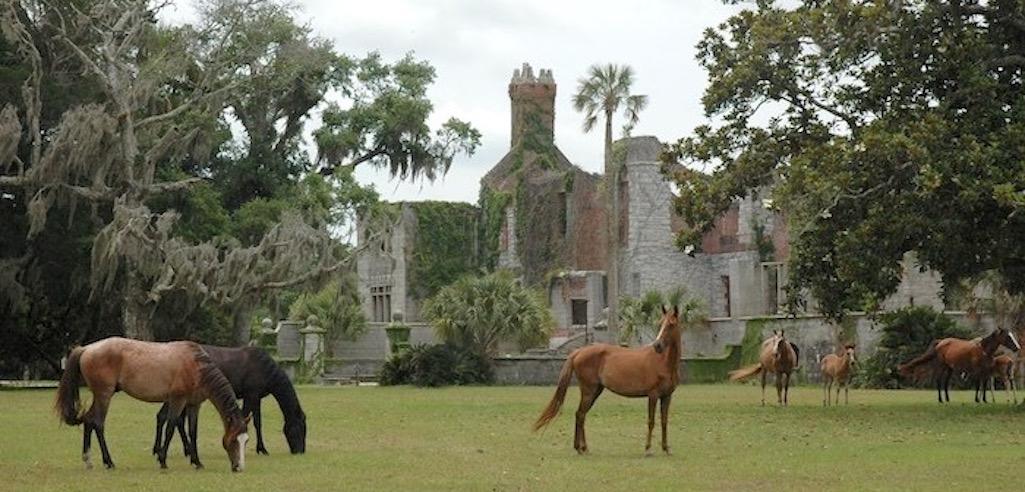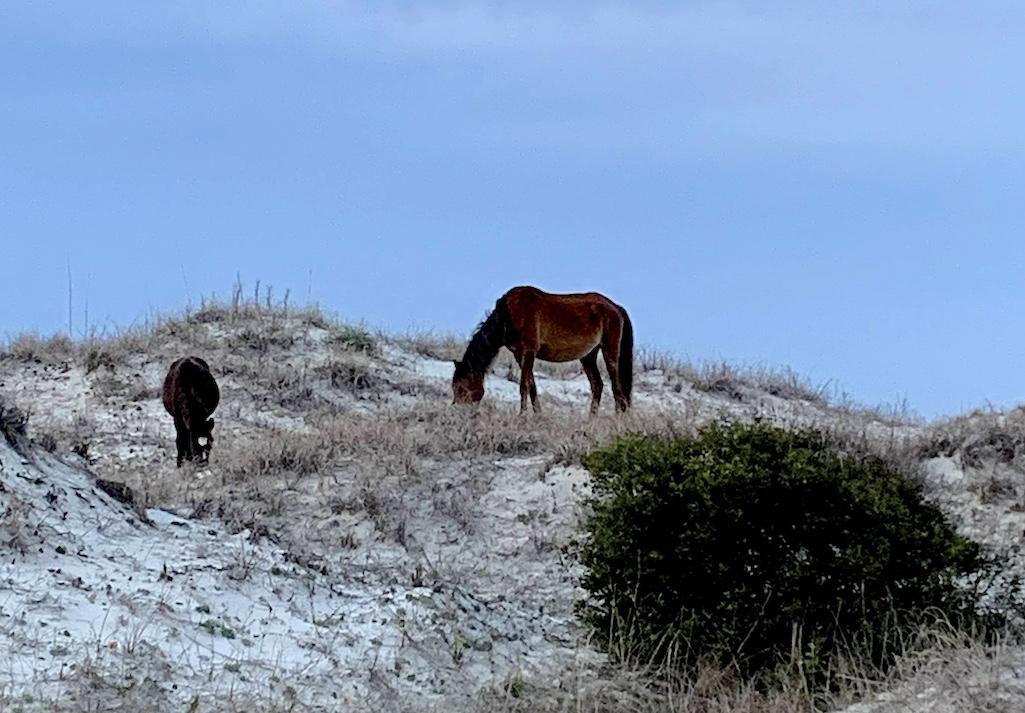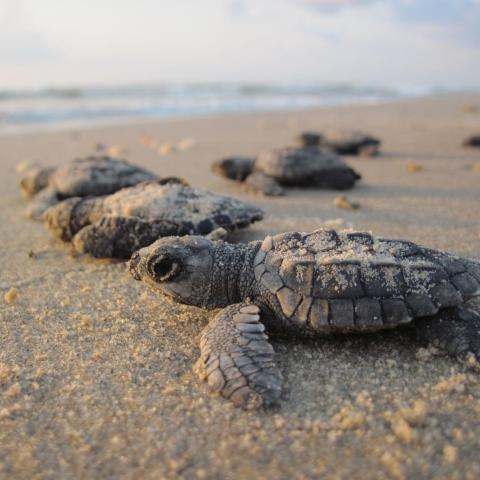
Feral horses have the run of Cumberland Island National Seashore with no management plan by the Park Service/NPS filke
A decade after the National Park Service acknowledged feral horses at Cumberland Island National Seashore are a nonnative species that has damaged natural, cultural, and historical resources and that a management plan needed to be developed for them, the agency still lacks such a plan and is facing what could potentially become a public relations nightmare by opposing emergency food and water for them.
For more than a year the Park Service has been mired in a lawsuit that seeks to humanely remove the 100 or so horses from the 18-mile-long island off the coast of Georgia and place them in a more ecologically suitable mainland setting. But the agency, backed by Justice Department lawyers, has so far neglected to act on that management plan recommendation from ten years ago and has maintained during the current litigation that it's not at fault if the horses trample nests, eggs, turtle hatchlings, and fledging birds of endangered species.
In seeking the lawsuit's dismissal, DOJ said there was no evidence that Park Service staff at the national seashore had adversely impacted endangered loggerhead sea turtles or piping plovers by failing to protect them from the horses, and that it was "unaware of any cases in which a court has held that a federal agency is liable for a take of one animal perpetrated by another..."
"Because horses are not a 'person' under the [Endangered Species Act], they cannot 'take' loggerhead turtles or piping plovers," DOJ said in their request to dismiss the lawsuit.
While plaintiffs in the case now want U.S. District Judge Sarah Geraghty to order the Park Service to provide food and water for the horses, noting that this past June was the driest in the area more than 130 years and that natural seeps and ponds were either depleted or dry and some horses visibly malnourished, DOJ says she can't rule on that motion until she rules on the motions to dismiss the lawsuit, and that if she dismisses the lawsuit, the motion for emergency food and water is moot.
Read why the Justice Department opposes emergency food and water for Cumberland Island's horses.
"Turning a blind eye to the suffering of any animal is inhumane," Jessica Howell-Edwards, the executive director of Wild Cumberland, which advocates for a natural Cumberland Island National Seashore, told me. "This litigation gave the agency an opportunity to demonstrate compassion for these animals; instead they have intentionally avoided doing so, shifting additional and unnecessary costs on to taxpayers."
The Traveler has been unable to independently evaluate the condition of Cumberland Island's horses. A video produced by Wild Cumberland claims the lack of grasslands and adequate water sources on the island has left some horses with intenstinal blockages caused by the ingestion of sand and salt, and depicts horses with sores and missing hair in place. On others, ribs and shoulder bones are easily seen. While domestic horses might live 30 years, the video notes, those on Cumberland Island on average live less than nine years.

The horses roam the dunes and beaches, where they allegedly trample eggs and nests of endangered species/Wild Cumberland file
While the Park Service won't discuss the issue due to the current litigation, in the past they've maintained the horses are doing OK. Former Superintendent Gary Ingram, now superintendent at Rocky Mountain National Park, in April 2023 told us the Park Service "has monitored the horses annually with population census techniques since 1981. Condition ratings for observed animals have been predominantly in the 'good' to 'moderate' categories. At no time during the last 41+ years have there been findings indicating that the overall health of the herd was in extremely poor condition."
Still, the Park Service's position, or lack of one, at Cumberland Island stands out when you look out across the National Park System.
At Cape Lookout National Seashore on the Outer Banks of North Carolina, the Park Service actively manages a herd of feral horses on Shackleford Banks. The agency monitors the herd's health and uses contraceptives to control the size of the herd at 120-130 individuals.
"Selected young horses have been removed during roundups, and, more recently, individually under veterinary sedation," a park brochure on the horses' management explains. "They are adopted by the public or donated to other wild herds. Immunocontraception (birth control) vaccines, effective for one year, are administered in the field without tranquilizers to selected mares."
At Assateague Island National Seashore in Maryland and Virginia, the Park Service works to control the feral horse population there to "minimize impacts" to vegetation on the seashore. "... ecological studies revealed that heavy grazing contributed to a reduction in the abundance, density, size and diversity of plants in both wetland and dune habitats," states a webpage on the horses on the seashore's website. "Scientists also noted that fauna found within those habitats were impacted negatively by the reduction of habitat quality."
The National Park Service is now evaluating future management of the horse herd on Ocracoke Island, North Carolina, managed under Cape Hatteras National Seashore. The current population of 11 horses, which are confined in a fenced paddock on Ocracoke, receive year-round feeding and “significant veterinary care,” according to Superintendent David Hallac.
At Mesa Verde National Park in Colorado, staff from time to time deals with trespassing horses that enter the park. "The presence of trespass livestock is inconsistent with the park’s mission to preserve the cultural and natural resources within the park and has caused damage to springs, riparian areas and archaeological sites and objects," the Mesa Verde website points out.
At Cumberland Island National Seashore, the Park Service seems to have ignored its own 2014 "foundation document" crafted to guide management actions.
"The feral horse population that has free range on Cumberland Island is a nonnative species that has documented adverse impacts on the island’s natural resources. General observations also point to additional impacts that have not been thoroughly investigated and/or documented. Likewise, observations also indicate that they have an adverse impact on cultural resources including archaeological and historic features," part of the document reads.
"However, the horses are extremely popular with many visitors, stakeholders, and segments of the general public," the document continues. "Many visitors view them as a fundamental part of their experience on Cumberland Island. In addition, there are realistic as well as speculative concerns about the horses’ health. Given all of these factors and the emotions involved, managing the horses and their impacts is a highly political and sensitive issue. Development of a feral horse management plan will be a decidedly complex and challenging undertaking. Moreover, management actions put forth in the plan will require significant funding and long-term operational commitments. Nonetheless, such a plan is necessary [emphasis added] to protect the island’s natural and cultural resources and take into account the health of the horses.”
A long-term management plan that calls for supplemental feeding would very possibly be cost-prohibitive at Cumberland Island, where the horse population could range from 150-200, according to the park's website. At Cape Hatteras, which has 11 "Banker ponies," costs to feed and water them throughout the year probably run $45,000, based on current hay and grain prices.
"Feral or native….the horses on Cumberland Island do not deserve to suffer needlessly, especially when it’s in the National Park Service’s power to do a course correction," Elaine Leslie, the Park Service's chief of biological resources before retiring, told us after learning of DOJ's opposition to emergency feeding. "Horse issues in the NPS need to be addressed consistently and comprehensively and the agency has the tools to do just that through law and policy. While visitors may come to the island to see these non-natives, one would hope through education that they will in time come to appreciate the native species and ecosystems once restored. And we can only hope that parks learn and take examples from history…such as how Mesa Verde turned around their nasty situation.
"This situation is no fault of the horses, but of humans," she added. "There is no need, in spite of a lawsuit, to be abusive and cruel."
While the Park Service at Cape Lookout was directed through federal legislation to manage the horses as part of the seashore's cultural history, that doesn't seem to be the case at Cumberland Island. There also doesn’t appear to be significant controversy over whether or not the horses should remain — in contrast to recent events at Theodore Roosevelt National Park, where pressure from politicians and the public prompted the Park Service to abandon a plan to remove the feral horses at that park.
But has the Park Service even sought the funding to complete and implement the feral horse strategy they acknowledge they need at Cumberland? To stand by and watch lawyers battle in court while the feral horses continue to inflict damage on the national seashore and its native species while also apparently struggling to survive falls far short of the agency's mission to preserve "unimpaired the natural and cultural resources and values of the National Park System."
"Good stewardship would require us to show compassion to these animals that are suffering," Howell-Edwards told me last year after the lawsuit was filed. "But also good stewardship would require us to demonstrate respect for the ecosystems that they're damaging."
Traveler reached out to a few Park Service sources, asking off the record why they thought the agency and Justice Department would oppose providing water and feed to the horses, assuming that the animals were actually in distress. One retired superintendent summed it up in one word: “Precedent.” They observed that if a court orders the Park Service to water and feed non-native animals, particularly those that are documented to be causing ecosystem damage, then the agency moves one step closer to being a zoo. The precedent might then be applied (perhaps even mandated) across the National Park System, requiring care for a wide range of animals challenged by weather, predators, urban encroachment, etc.
They acknowledged, however, that the conditions at Cumberland Island are hardly “natural” so letting “nature take its course” was hardly an apt response, either.




 Support Essential Coverage of Essential Places
Support Essential Coverage of Essential Places







Comments
Oh boy! The horse controversy has everyone tied in knots again. I am familiar with Assateague Island in Maryland, and there the horses are a big draw for tourists. They dominate the landscape and excite crowds. They are a resource to be cherished, perhaps a cultural resource though. Legally, and technically they are feral animals and on one hand should be eliminated. However, they are so loved and make so many people happy, not to mention the economic improvement the horses bring to the community it would be foolish to get rid of them. I am of the opinion they should stay, but managed so their numbers are kept low.
The agency lacks leadership. They can't get rid of ranch animals fast enough @ Valles Caldera but here they stew about caring for an invasive species. They pride themselves on "following the science", but really, like in the White Nose Syndrom response at cave parks, they are controlled by emotions.
Immediately round up and either sell or shoot the horses. Protect the natural environment for future generations. That is your job.
DOJ argument is wrong. NPS is a person under the ESA. By an act of omission or comisssion, NPS tolerance or support for the horses that harm listed species is a section 9 take by the NPS. Yes DOJ, an animal can cause harm to listed animals. See Palila v Hawaii. Further, ESA imposes on the NPS an affirmative obligation to conserve listed species not feral livestock. Disgraceful that DOJ would proffer an argument more fitting to an Administration that was openly hostile to the ESA. Lets hope they do not succeed.